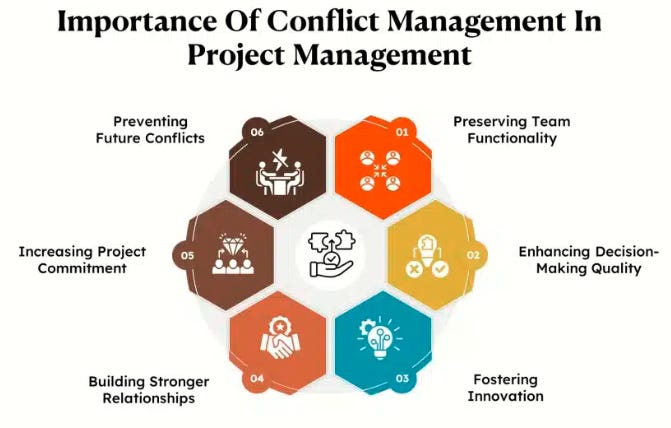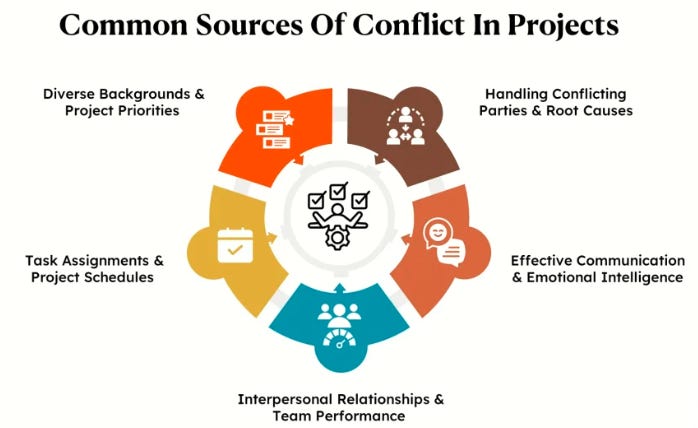Turn Project Conflict into Success: Master Resolution Strategies Today!
Navigate Tension Like a Pro and Keep Your Project on Track
"Effective conflict resolution transforms challenges into opportunities, keeping your project on track and your team united."
Follow me for more Project Management Insights: LinkedIn | LinkedIn Newsletter
Projects rarely unfold without challenges; conflict is one of project managers' most significant obstacles. Conflict can derail progress, hinder collaboration, and create unnecessary tension within the project team or between stakeholders. However, when approached with the right strategies, conflict can be transformed into a valuable opportunity for growth and alignment. Understanding how to manage and resolve conflict is crucial for maintaining momentum and ensuring successful project delivery.
This edition of The PM Playbook explores strategies for addressing conflicts within the project team or between stakeholders.
What You’ll Find in This Article:
Understand the root causes of conflict in projects.
Apply effective communication strategies for resolution.
Build a collaborative approach to addressing conflicts.
Use negotiation tactics to resolve stakeholder disagreements.
Manage emotions with empathy and prevent future conflicts.
Understanding the Root Causes of Conflict
Understanding the root causes of conflict is paramount before diving into conflict resolution strategies. Project conflict often stems from diverse sources, such as personality clashes, communication breakdowns, unclear expectations, or team power dynamics. When left unaddressed, these underlying factors can escalate into larger issues that disrupt collaboration and hinder project success. Identifying these root causes helps project managers address conflicts effectively rather than treating only their symptoms.
The first step in resolving conflict is to assess its origin and the contributing factors. This involves observing team dynamics, listening actively to all parties involved, and seeking to understand the perspectives and motivations behind disagreements. For instance, miscommunication might arise from differences in communication styles, while unclear expectations could result from poorly defined project objectives or ambiguous roles. Recognizing these nuances allows project managers to pinpoint the real drivers of discord, making it easier to tailor solutions that address the core issues.
By identifying the root cause, project managers are better positioned to implement the most effective resolution strategies. Whether it involves clarifying roles, improving communication channels, or mediating disputes, addressing the source ensures long-term harmony within the team. Moreover, understanding these root causes equips project managers with insights to prevent similar conflicts in the future, fostering a culture of transparency, collaboration, and trust. This proactive approach resolves issues and strengthens the foundation for sustained project success.
Common Causes of Conflict
Conflict is inevitable in any project, predominantly when diverse teams work under tight deadlines and high-pressure conditions. While some levels of disagreement can be healthy and lead to innovation, unresolved conflicts can derail progress, damage relationships, and lower team morale. For project managers, understanding the sources of conflict is the first step toward effective resolution and maintaining a productive work environment.
Addressing conflict begins with identifying its root causes. Conflicts rarely emerge in isolation, often triggered by more profound issues that must be uncovered and addressed. By recognizing the common factors that lead to disagreements, project managers can better anticipate challenges, foster open communication, and implement strategies to resolve tensions before they escalate. Below are some of the most common causes of conflict in project environments:
Miscommunication: Poor communication often leads to misunderstandings, which can escalate into conflict.
Personality Differences: Clashing personalities and working styles can create friction within the team.
Unclear Expectations: When roles, responsibilities, or deliverables aren’t clearly defined, it can lead to confusion and disputes.
Competing Priorities: Conflicting goals or priorities between stakeholders or team members can fuel tension.
Power Imbalances: When one party feels they lack control or influence, it can lead to frustration and conflict.
Pro Tip: Understanding the cause of the conflict early allows you to apply the proper resolution technique. Don’t hesitate to engage with all parties to get a comprehensive view of the issue before taking action.
Effective Communication Strategies for Conflict Resolution
Communication is at the heart of conflict resolution. How you approach the conversation with the team or stakeholders can make all the difference. Whether you’re discussing the issue with your team members or mediating between conflicting stakeholders, maintaining open, respectful, and transparent communication is key to resolving conflict. By fostering an environment of transparency and active listening, you’ll be better equipped to address the underlying issues and move forward.
Tips for Effective Communication:
Listen Actively: Allow each party to express their perspective fully before responding. This shows respect and helps identify the real issue.
Be Clear and Concise: Avoid vague statements. Being specific about the conflict and its impact helps avoid further misunderstanding.
Maintain Respect: Acknowledge different viewpoints without judgment, always ensuring a respectful dialogue.
Focus on Solutions, Not Blame: Shift the conversation toward resolving the issue rather than assigning blame. This fosters collaboration.
Pro Tip: Use "I" statements instead of "you" to avoid sounding accusatory. For example, say, “I feel concerned about the delay” instead of “You caused the delay.”
Building a Collaborative Conflict Resolution Approach
Conflict resolution doesn’t always need to be a top-down decision-making process. The best solutions often come from the people involved in the conflict. A collaborative approach invites those in conflict to work together for a mutually acceptable resolution. This approach resolves the immediate issue, builds trust, and strengthens relationships, making it easier to tackle future challenges.
Key Elements of Collaboration:
Inclusive Problem-Solving: Involve all parties in the resolution process to foster a sense of ownership.
Common Ground: Identify areas where both parties agree and use them as a foundation for finding a solution.
Flexibility: Be willing to compromise and look for win-win outcomes rather than forcing one side to concede.
Empathy: Show understanding and a willingness to understand the other person’s viewpoint.
Pro Tip: Regularly check in with all parties after a resolution to ensure the solution works and any lingering issues are addressed. This continuous feedback loop helps maintain alignment.
Negotiation Tactics for Stakeholder Disagreements
Stakeholder conflicts are common in project management and can arise when stakeholders have competing priorities or different expectations about project outcomes. Negotiation is often the best approach for resolving these conflicts, as it involves finding a compromise that satisfies both parties. Understanding negotiation tactics and managing these conversations effectively is key to keeping your project on track.
Key Negotiation Strategies:
Know Your Bottom Line: Understand what you can and cannot compromise before entering negotiations.
Seek Win-Win Solutions: Strive for agreements that benefit all parties and align with project objectives.
Stay Calm and Focused: Control your emotions during negotiations. Stay objective and focused on finding a solution.
Use Data and Facts: Present data or evidence to support your position and make the case for your proposed solution.
Pro Tip: When preparing for stakeholder negotiations, gather as much information as possible about their concerns and interests. The more you know, the easier to find common ground.
Managing Emotionally Charged Situations with Empathy
Emotions often run high in high-stress project environments. Whether dealing with a frustrated team member or a dissatisfied stakeholder, it’s essential to manage emotionally charged situations with empathy. Empathy allows you to understand the emotional state of others, which can help you de-escalate the situation and move toward a solution that satisfies all parties.
Managing Emotions Effectively:
Acknowledge Emotions: Let the other party know you understand their feelings, which can help validate their concerns.
Stay Calm Yourself: Your ability to stay composed can have a calming effect on others. Keep your emotions in check and maintain a level-headed approach.
Encourage Open Expression: Allow people to express their emotions safely and constructively without interruption.
Reframe the Conversation: Focus the conversation on solutions, not emotions, while respecting the individual's emotional state.
Pro Tip: Use techniques like deep breathing or pausing before responding to control your emotions during difficult conversations. This helps you stay calm and objective.
Establishing a Conflict Resolution Framework
A framework is essential for proactively addressing conflict. A well-defined conflict resolution process provides clarity and direction when issues arise. By establishing clear steps for addressing conflict, project managers can handle disputes consistently and efficiently, reducing their impact on the overall project.
Steps in a Conflict Resolution Framework:
Identify the Issue: Clearly define the problem and gather all parties' input.
Analyze the Situation: Assess the root cause of the conflict, considering any underlying issues.
Develop Potential Solutions: Work with stakeholders or the team to brainstorm possible solutions.
Implement the Solution: Agree on a course of action and implement the resolution.
Follow-Up: Check in to ensure the solution is working and address any lingering issues.
Pro Tip: Establish a conflict resolution framework early in the project and ensure all team members and stakeholders know it. Having a pre-established process makes it easier to handle disputes when they arise.
Proactive Conflict Prevention Techniques
While conflict is often inevitable, proactive measures can help minimize its occurrence and impact. By fostering a culture of open communication, clearly defining roles, and aligning expectations from the start, project managers can prevent many conflicts from arising in the first place.
Key Prevention Techniques:
Set Clear Expectations: Ensure that all team members and stakeholders understand project goals, timelines, and responsibilities.
Encourage Open Communication: Create an environment where individuals feel comfortable discussing concerns before they escalate into conflict.
Foster Team Collaboration: Promote a collaborative culture where team members support each other and work together toward shared goals.
Regular Check-Ins: Conduct frequent status updates and check-ins to catch issues early before they turn into conflicts.
Pro Tip: Encourage team members to raise concerns early by providing anonymous feedback channels. This allows you to address potential issues before they escalate.
Final Thoughts
Conflict is inevitable in project management but doesn’t have to derail your efforts. By mastering conflict resolution strategies and fostering an environment of open communication, empathy, and collaboration, project managers can turn disputes into opportunities for growth and alignment. The key is approaching conflict with a calm, solution-focused mindset and the willingness to adapt as the situation evolves.
By proactively managing and resolving conflict, you ensure that your project remains on track, your team remains motivated, and stakeholders stay engaged. The better you handle conflict, the stronger your leadership will be, paving the way for future project success.
Follow me for more Project Management Insights: LinkedIn | LinkedIn Newsletter



